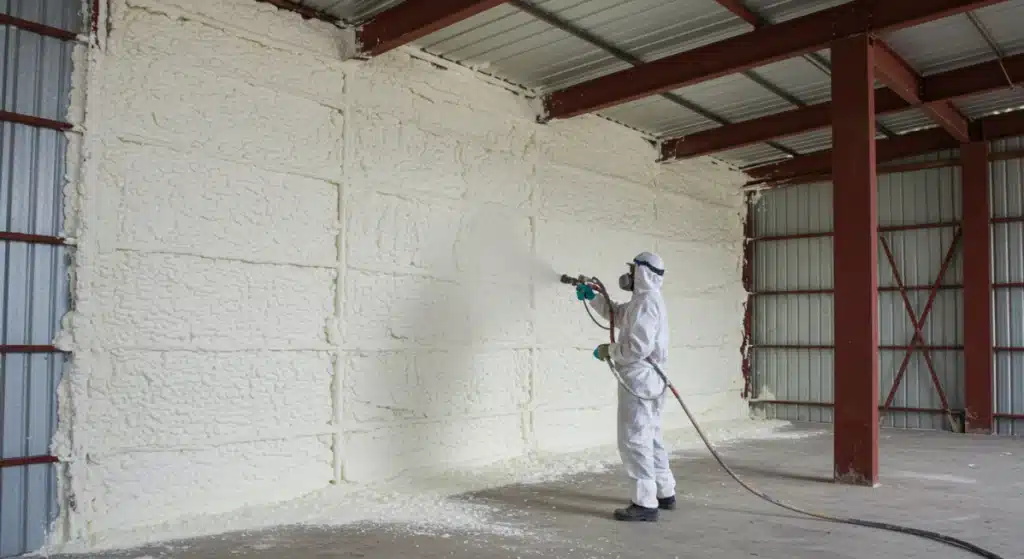Spray foam insulation provides high thermal resistance, air sealing, and moisture control in a single application. Buildings with large open areas, high energy usage, or humidity-sensitive environments benefit the most. Warehouses, refrigerated storage facilities, metal buildings, and medical or manufacturing sites see measurable energy savings, structural protection, and indoor comfort improvements.
This article outlines which commercial building types are best suited for spray foam insulation, using firsthand experience in regional applications. It provides technical data, climate-based performance insights, and practical comparisons based on direct job site observations.
Building Types That Benefit Most
Common Commercial Applications
| Building Type | Key Benefit from Spray Foam | Why It Matters |
|---|---|---|
| Warehouses | Thermal control + Air sealing | Reduces HVAC strain in large open-air volumes |
| Cold Storage/Refrigeration | Moisture barrier + High R-value | Maintains temperature consistency, prevents mold |
| Metal Structures | Condensation prevention | Prevents rust, extends roof lifespan |
| Medical or Lab Facilities | Indoor air quality control | Reduces airborne infiltration and contaminants |
| Schools and Educational Buildings | Energy savings + Acoustic dampening | Cuts operational costs, improves learning environment |
| Retail Buildings | Draft and humidity control | Enhances customer comfort, protects goods |
Climate-Based Suitability
Spray foam performs especially well in the Texas Panhandle climate. Temperature extremes, seasonal wind, and low humidity place high demand on insulation systems. Spray foam’s closed-cell variants offer strong resistance to air leaks and heat transfer, even under sustained summer exposure and fluctuating winter conditions.
Technical Performance Details
| Property | Closed-Cell Spray Foam | Open-Cell Spray Foam |
|---|---|---|
| R-Value per Inch | 6.0 – 7.0 | 3.5 – 3.7 |
| Air Barrier | Yes | Yes |
| Vapor Barrier | Yes | No |
| Water Resistance | High | Low |
| Density | ~2.0 lb/ft³ | ~0.5 lb/ft³ |
| Application Areas | Roofs, exterior walls, cold storage | Interior walls, sound dampening |
Bonus Tip: Use closed-cell foam in any area subject to moisture or where structural reinforcement is needed.
Things to Consider Before Making a Decision
- Building Purpose: Storage, occupancy, or production needs influence insulation type.
- Roofing Type: Metal roofs require vapor barriers. Flat or low-slope roofs may benefit from dual-layered systems.
- Interior Access: Existing structures may need selective access for retrofit installations.
- Code Compliance: Verify local fire ratings, thermal requirements, and air-seal standards.
- Budget vs. Long-Term Savings: Upfront material cost is higher, but lower HVAC load can offset installation within 3–5 years.
Bonus Tip: For retrofits, infrared thermography identifies leakage hotspots before insulation starts.

Related Services Offered by Flatland Roofing & Insulation
Flatland Roofing & Insulation provides focused insulation and roof sealing services that directly address commercial performance needs:
- Commercial Insulation Solutions: Application of spray foam in warehouses, cold storage, and metal buildings to boost energy efficiency.
- Blown-In Insulation Installation: Loose-fill options used where spray foam access is limited or cost-prohibitive.
- Commercial Roof Coating: Seamless protective coatings that reflect heat and extend the roof lifespan.
- Metal Roof Restoration: Targets rust-prone seams and fasteners, integrating with spray foam systems to prevent condensation.
- Get Expert Insulation Guidance
- For commercial properties in West Texas needing energy-efficient insulation or moisture control, Flatland Roofing & Insulation offers proven solutions. Contact the team for project evaluations and application strategies.
Flatland Roofing & Insulation Phone: (806) 606-6794 Email: [email protected]
Common Questions Before Choosing Spray Foam
How thick should the spray foam layer be?
Minimum thickness depends on building use, but 2″ closed-cell foam often meets air barrier and R-value needs.
Can spray foam be applied over old insulation?
Not recommended. Removing compromised material ensures proper adhesion and performance.
Does spray foam increase structural strength?
Closed-cell foam adds racking strength to walls and ceilings, especially beneficial for metal buildings.
What are the odor concerns?
Installers must follow proper curing time. Post-curing, the material is inert and odorless.
FAQ Section
What is the typical lifespan of commercial spray foam insulation?
With proper installation, closed-cell spray foam lasts 30–50 years without significant performance loss.
How does spray foam handle roof movement or expansion?
It expands with the building substrate to prevent cracking or separation, especially in metal roofs.
Are there health risks with spray foam?
Only during installation. Cured foam does not emit harmful fumes or particles.
Can spray foam be used in humid environments?
Yes, especially closed-cell foam, which prevents moisture absorption and mold.
Is maintenance required after installation?
Routine inspections every 2–3 years are recommended, especially in high-traffic or weather-exposed areas.






